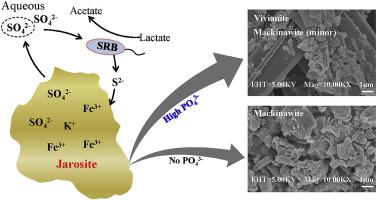Ecotoxicology and Environmental Safety ( IF 6.2 ) Pub Date : 2020-06-29 , DOI: 10.1016/j.ecoenv.2020.110921 Kun Gao 1 , Yue Hu 1 , Chuling Guo 1 , Changdong Ke 1 , Chucheng He 1 , Xinrui Hao 1 , Guining Lu 1 , Zhi Dang 1

|
Jarosite is one of the iron oxyhydroxysulfate minerals that are commonly found in acid mine drainage (AMD) systems. In natural environments, phosphate and sulfate reducing bacteria (SRB) may be coupled to jarosite reduction and transformation. In this research, the effect of phosphate on jarosite reduction by SRB and the associated secondary mineral formation was studied using batch experiments. The results indicated that Fe3+ is mainly reduced by biogenic S2− in this experiment. The effect of PO43− on jarosite reduction by SRB involved not only a physico-chemical factor but also a microbial factor. Phosphate is an essential nutrient, which can support the activity of SRB. In the low PO43− treatment, the production of total Fe2+ was found to be slightly larger than that in the zero PO43− treatment. Sorption of PO43− effectively elevated jarosite stability via the formation of inner sphere complexes, which, therefore, inhibited the reductive dissolution of jarosite. At the end of the experiment, the amounts of total Fe2+ accumulation were determined to be 4.54 ± 0.17a mM, 4.66 ± 0.22a mM, 3.91 ± 0.04b mM and 2.51 ± 0.10c mM (p < 0.05) in the zero, low, medium and high PO43− treatments, respectively, following the order of low PO43− treatment > zero PO43− treatment > medium PO43− treatment > high PO43− treatment. PO43− loading modified the transformation pathways for the jarosite mineral, as well. In the zero PO43− treatment, the jarosite diffraction lines disappeared, and mackinawite dominated at the end of the experiment. Compared to PO43--free conditions, vivianite was found to become increasingly important at higher PO43− loading conditions. These findings indicate that PO43− loading can influence the broader biogeochemical functioning of AMD systems by impacting the reactivity and mineralization of jarosite mineral.
中文翻译:

吸附的磷酸盐对硫酸盐还原菌还原黄铁矿的影响及相关的矿物学转化。
黄铁矿是在酸性矿山排水系统(AMD)中常见的一种羟基羟基硫酸铁矿物。在自然环境中,还原磷酸盐和硫酸盐的细菌(SRB)可能与黄铁矿的还原和转化有关。在这项研究中,使用分批实验研究了磷酸盐对SRB还原黄钾铁矾及其相关次生矿物质形成的影响。结果表明,在该实验中,Fe 3+主要被生物源S 2-还原。PO 4 3-对SRB还原黄钾铁矾的影响不仅涉及物理化学因素,还涉及微生物因素。磷酸盐是一种必需营养素,可以支持SRB的活性。在低PO 4 3−处理后,发现总Fe 2+的产生比零PO 4 3-的处理略大。PO 4 3−的吸附通过形成内球络合物有效地提高了黄钾铁矾的稳定性,因此抑制了黄钾铁矾的还原溶解。在实验结束时, 零处的总Fe 2+累积量确定为4.54±0.17 a mM,4.66±0.22 a mM,3.91±0.04 b mM和2.51±0.10 c mM(p <0.05) ,低,中和高PO 4 3−分别按照低PO 4 3-处理>零PO 4 3-处理>中PO 4 3-处理>高PO 4 3-处理的顺序进行处理。PO 4 3-负载也改变了黄钾铁矾矿物的转化途径。在零PO 4 3-处理中,黄钾铁矾衍射线消失了,在实验结束时,以马基诺石为主。与不含PO 4 3-的条件相比,发现在更高的PO 4 3-负载条件下,堇青石变得越来越重要。这些发现表明PO 43-负载可通过影响黄钾铁矾矿物的反应性和矿化作用来影响AMD系统更广泛的生物地球化学功能。











































 京公网安备 11010802027423号
京公网安备 11010802027423号